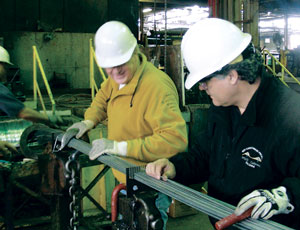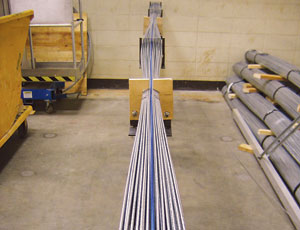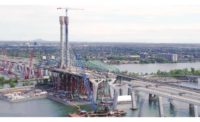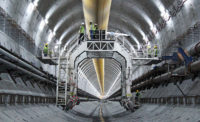As the highlight of a $1.8-million, four-year federally funded research program, academic and industry researchers have begun testing multiple types of bridge-cable sensors in a chamber generating real-world-based corrosive conditions at Columbia University in New York City. The six-month test, launched on Dec. 23, has the world’s only cable mockup tested under 1.2-million lb of tension, say Columbia officials.


The 20-ft-long mock suspension-bridge cable has a diameter of 20 in. and is made of nearly 10,000 steel wires, each 5 millimeters in diameter. Researchers will expose the cable to the equivalent of decades of outdoor exposure in six months. If the sensors survive the test, they will be installed on a New York City suspension bridge.
Columbia leads a team including Parsons Transportation Group, a unit of Parsons Corp., Pasadena, Calif., and Physical Acoustics Corp., Princeton Junction, N.J., and various universities and firms that began preparing for the six-month laboratory test in late 2004, says Raimondo Betti, Columbia professor and lead project engineer. “The first phase was to do a thorough review of [sensor] technology currently available,” he says.
In the second phase, the team tested the selected technologies and monitored corrosion on strands of a New York bridge. “There is not one single sensor or technology to solve everything,” he says. “You have to fuse them together to get more reliable systems.” More than 70 sensors of various types are now installed deep within the mock cable. Current cable monitoring involves acoustic emission sensors that can only detect breaks in surface wires, researchers say. This test aims to go deeper.
“Each sensor company makes their own sensor,” notes Mark Carlos, president of Physical Acoustics. “Our role was sensor selection and integration into the mock cable.” The sensors measure acoustics, temperature hu-midity, strain and corrosion, “just to name a few,” says Carlos. His firm created a data acquisition system that will integrate all of them.
Both the indirect sensors, which provide internal indications about the cable environment such as humidity and temperature, and direct sensors, which provide quantifiable assessment of corrosion, will be assessed. “The goal is to develop a system that can help analyze [real] bridges and corrosion activity and determine the remaining life of the cable,” Carlos says, noting that direct sensors are more expensive. “If we can do something with lower-cost sensors, we win. If we end up with a system that’s too expensive, we have not achieved our goal.”
Dyab Khazem, Parsons project manager, says the team adopted aerospace examples to develop miniature indirect sensors that fit into tiny voids within the wires, yet could withstand cable pressure. When choosing from the initial array of sensors, the team wanted those that could be adapted to last at least 15 years, use solar power and have wireless nodes.
The third phase was construction of the mock cable and chamber. “Building a cable mockup under tension, simulating actual construction conditions, is unprecedented in a lab,” says Khazem. Mimicking actual suspension-bridge building techniques with a spinning wheel and counterweights would have cost $30 million. Instead, the team pulled the wires straight using a customized stand-mounted reel. The wires were squeezed through comb-like forms while anchored at one end to maintain tension. “We will subject it to rain, heat and salt,” says Betti.




Post a comment to this article
Report Abusive Comment